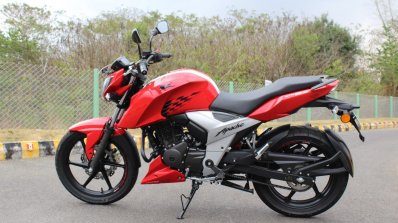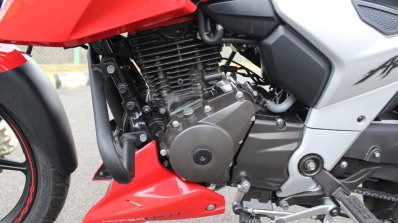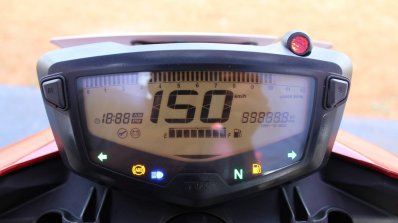2018 TVS Apache RTR 160 4V - First ride review
Overview:
The 150cc market in India is one of the most happening segments after the quantity-driven 100-125 cc commuter space. It is easy to see why: this segment offers both frugality and sportiness in one delectable package that wouldn’t burn a hole in the pocket either. Indian manufacturers like Bajaj and TVS made their presence felt among the hearts of enthusiasts, particularly because of bikes like the Pulsar and Apache. The TVS Apache emerged into our markets in 2006, and six years later, the bike went through a major design and technical upgrade, complete with aerodynamic bodywork, LED DRL, and a powerful engine.
Also Read: TVS Ntorq 125 first ride review
The Apache also breathed a new lease of life into the TVS One Make Championship, with its performance-centric purpose. Slowly, enthusiasts craved more technology, and this demand made the way for bikes like the Gixxer, FZ-16 and the Hornet. TVS did their homework, and arrived at a conclusion that scaling down the potent RTR 200 4V model could be the solution. Read on to know if it has worked.
Design:
A fleeting glance at the 2018 TVS Apache RTR 160 4V, and the first thing that pops up into your mind would be its elder brother the RTR 200. The motorcycle has a mass-forward design, with a muscular fuel tank surround by tank shrouds. The sleek headlamp diverts the visual mass to the tank; the tail light, side and rear panels are reminiscent of the RTR 200. I particularly like the way the graphics are minimal in this motorcycle. The chequered flag sticker located just behind the tank vents give it a nice flowing feel, and the TVS logo on the tank looks elegant. The black alloys come with rim stickers with TVS Racing logo emblazoned.
The bike comes with a single-piece handlebar and a single-piece seat in favour of better comfort. The riding position is upright, and the seat is well-cushioned. The exhaust is the same double-barrel unit that’s found in the RTR 200. The rear wheel comes with a tyre hugger for better practicality.
Features:
The 2018 TVS Apache RTR 160 4V comes with a fully-digital instrument cluster that has a similar design as the RTR 200. The Carburettor variant comes with an Amber colour backlit digital console, while the fuel injected version features a white backlight. The fuel injected version also features gear position indicator, text display area, top speed and acceleration recorder, lap timer, low-fuel trip mode; whereas the carb variant misses out on these.
The instrument cluster also has a provision for immobiliser and ABS, which may be incorporated in the future. Both bikes get a programmable shift light; clock; low battery and service indicators as well. The choke in the carb version is located just behind the fuel tap. The 12-litre fuel tank features an off-set cap, just like the RTR 200.
Performance:
The 159.7 cc single cylinder engine with air and oil cooling is based on the RTR 200, but has been reworked on multiple fronts to suit this motorcycle. Thanks to the counterbalancer, the engine is refined up until 9,000 rpm. The maximum power (16.8 PS for FI, 16.5 PS for carb) peaks out at 8,000 rpm. The FI version has crispier throttle response, but I managed to reach a higher top speed in the carb (114 kmph) than in the FI (111 kmph). The claimed top speed for FI stands at 114 kmph, and for the carb, it is 113 kmph. The fuel injection also helps in easier cold starts and cleaner emission.
Also Read: TVS Apache RR 310 – First ride review
Coming to the cruising speed, the bike can easily trundle along at 90 kmph. The gear shifts are slick and precise, with the first gear long enough for easy movement in traffic. Gearbox is a five-speed unit, and there was not a single instance of facing false neutrals. The bike may not be as sprightly as the RTR 200, but can hold of on its own when competing with its rivals in the segment.
Handling:
The engine sits inside a double-cradle split Synchro Stiff frame. There is a telescopic fork up front, and the rear comes with a race-tuned Showa monoshock. The front fork features a fork seal guard as well. The front tyre measures 90/90-17 49P; and the rear comes with 130/70-17 M/C 62P Tubeless rubber. However, the carburetted rear drum brake version wears a 110/80-17 57P tubeless tyre at the rear. The single piece handlebar and seat offers very good comfort, with upright riding position.
I loved the RTR 200 for its sorted suspension and amazing brakes, and the RTR 160 lived up to my expectation. No matter what speed you do, just pull the brake levers and the bike decelerates with a reassuring rigour. The feedback is good, and the bite is ample. However, the bike still misses out on ABS. The suspension is well-sprung for tarmac, aiding the bike’s stability during cornering at TVS’ test facility. We are yet to see how the bike behaves on Indian roads. The TVS Remora tyres on the front and rear offer good grip, but start protesting when you push it to the limits. It shouldn’t be much of a deal breaker, though.
Verdict:
The options for the 2018 TVS Apache RTR 160 4V are flexible to entice the audience with different budgets and requirements. The motorcycle comes in three variants: Carburettor with front disc and rear drum (INR 81,490); carburettor with front and rear disc (INR 84,990); and Fuel Injected (FI) variant with both front and rear disc (INR 89,990). All prices ex-showroom, Delhi.
Also Read: 2018 TVS Apache RTR 160 4V vs Bajaj Pulsar NS 160 – spec comparison
It is evident that the brand is looking for a long-term market performance with the new Apache RTR 160, thanks to the future-emission-compliance-ready 4-valve engine, and modern cycle parts. But TVS will take the decision of phasing out the older-gen Apache bikes only on the basis of demand. When it comes to pricing, the FI variant is dangerously close to the Apache RTR 180 ABS, with a price difference of just INR 3,007. Overall, if you want a well-finished, refined and comfortable commuter that will be fun on the weekends as well, then the RTR 160 4V deserves to be in the shortlist.

















































